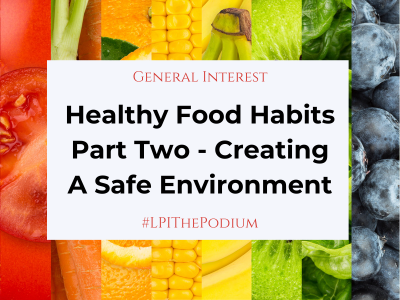
Last month we discussed controlled binge eating as a healthy food habit. In this month’s segment, we are talking about creating a safe food environment.
A “safe” food environment is one you feel good about, meaning you are able to go to the fridge, freezer, or pantry at any time and know that the choices in front of you will not result in food remorse. If your food environment is one that doesn’t feel entirely safe when you go into the kitchen and you are constantly faced with foods that challenge your desire to eat healthier, then it’s time to have an honest discussion with yourself. Who is going to be the one in charge – – you or the food? You are the only one who can change your food environment.
Here are some ways to get started and create a food environment that works for YOU:
Clear the pantry, fridge, and freezer of “trigger” foods that are likely to sabotage your efforts. In other words, those things you know will be too tempting for you to resist, especially in your weakest moments when you are seeking comfort food. Also be mindful of convenience foods that are all too easy to reach for when you are in a rush, or your hunger has reached a point of impatience.
Replace your go-to comfort foods with alternative choices. Search for options that will still satisfy that craving, but make you feel more in control. Some examples include:
- If you are a chocolate lover, consider options like snack pack-sized, sugar-free chocolate pudding, or dark chocolate rather than milk chocolate (which has less sugar).
- If you are a pasta lover, place individual servings in Ziplock bags so that when you reach for the pasta, YOU are controlling the amount (and it’s not controlling you!).
- Consider replacing fattier proteins with leaner alternatives, such as ground turkey rather than ground beef, chicken breast rather than dark meat pieces, thinly sliced lunchmeat rather than thicker slices, etc.
- Replace salt and other salted seasonings with salt-free alternatives (there are some really good ones out there!).
- Are you a cheese lover? Go for the Baby Bell or Laughing Cow cheese, especially if you like softer cheeses. These are usually smaller portions, while still being convenient and delicious. For regular cheese, the harder the cheese, the better it is for you.
- If ice cream is one of your trigger foods, try lower-sugar, less-fat versions, or replace the ice cream with Greek yogurt. Greek yogurt is good for you and can help satisfy that craving for something cold and creamy. Frozen fruit bars are another good alternative.
- Anything in the bread family is a huge trigger and comfort food for me. I now have low-carb/high-fiber options in my pantry – – bagel thins rather than full-sized bagels, low-carb or zero-carb tortillas, and thinly sliced bread with less carbs and more fiber/added protein. Now, when I reach for bread, it’s a safer choice for me.
Reduce the package size when shopping. Look for packaging that offers individual portions rather than “mega” portions. A lunch box-sized bag of potato chips is a much safer option than a party-sized bag. Small combination packs of nuts, crackers, fruit, and cheese are very satisfying, a great source of protein, and help to get you through those carb/sugar cravings.
Read labels! If you want to replace some of your foods with things that are supposed to be healthier, especially with prepared frozen meals, be sure you read the nutrition labels on the package. I am constantly amazed at “diet” or “healthy” options that are supposed to be better choices when it comes to fat, carbs, and sugar, but they are extremely high in sodium. Or foods that are high in protein but have very little fiber and still have large amounts of sugar. The majority of these are not safe foods and will sabotage your efforts to eat healthier in sneaky ways. Reading the labels means you are making yourself aware of exactly what you are choosing.
Deliberately choose items that YOU don’t like, but your family does like. For example, I am not a big fan of peanut butter cookies, but my husband loves them. So, while I have cookies in my pantry (one of my go-to comfort foods), the ones that are in there aren’t one of my favorites and I consider them safe to have in my food environment. Potato chips and nuts are another example. I pretty much buy chips that my husband likes that aren’t my favorites. And I love nuts, but I tend to go for the ones that are honey-coated, caramelized, or brown sugar-glazed, so I just buy regular salted peanuts instead since I know my husband loves them and I don’t.
By stocking your fridge, freezer, and pantry with things you enjoy eating but are better, healthier versions, you are making your food environment a safe place where YOU are in control (not the food!) and you are making choices that make you happy and feel empowered as opposed to remorseful or deprived.
Check back next month for “Healthy Food Habits, Part 3: But I’m Still Hungry!”
Categorized in: General
| << previous | next >> |








